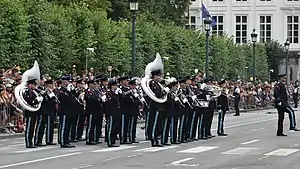Royal Band of the Belgian Guides
The Royal Band of the Belgian Guides[1] (Dutch: Groot Harmonieorkest van de Belgische Gidsen, French: Les Amis de la Musique Royale des Guides) is the premier musical component of the Belgian Army (Land Component). It is the largest and oldest of the three professional military bands of the Belgian Armed Forces. It formerly served as the regimental band of the Guides Regiment from 2004 to 2011. The combined ensemble is composed of over 100 musicians, including a 19-member bugle platoon.
| Royal Band of the Belgian Guides | |
|---|---|
| Koninklijke Muziekkapel van de Gidsen (KMG) Musique Royale des Guides (MRG) | |
 The Royal Band of the Belgian Guides performing on the Belgian National Day, 2018. | |
| Active | 16 August 1832 – Present |
| Country | |
| Allegiance | |
| Branch | |
| Type | Military band |
| Part of | Guides Regiment (2004 – 2011) |
| HQ | Brussels |
| Website | www |
| Commanders | |
| Bandmaster | Commandant Yves Segers |
| Adjutant-Major | Hans Demeurisse |
| Trumpet-Major | Olivier Brichau |
| Notable commanders |
|
Overview
It originated in August 1832, by order of King Leopold I of Belgium, as the Royal Band of the 1st Regiment. The King commissioned Jean-Valentin Bender. The formation accompanies the royal couple during all his movements. As a result, it gained the title of Musique Particulière du Roi (Private Music Band of the King). The success of the band was immediate and it was soon regarded and as one of the best music formations on the European continent. In the 20 year period between the two World Wars, the band gained an international reputation, as well as notability that it has never seen before. Under the baton of Arthur Prévost, it conducted an official tour of the United States in 1929, even being received by President Herbert Hoover in the White House. The 18 Days' Campaign severely damaged the structure of band, with most band members being sent into exile in the United Kingdom. On 4 September 1944, the band received the honor perform for the Belgian people following the country's liberation by allied forces. In early 1957, Simon Poulain went into retirement and on 11 February 1957, the Minister of National Defense appointed Lieutenant Karel Torfs to succeed him. By 1962, the band had conducted over 1,000 concerts in Belgium, and by 1985, had successfully participated in major international festivals. On 16 June 2007 François De Ridder, who was the bandmaster for only 4 years, was killed in Zellik while carrying out an assignment as an volunteer firefighter in the city.
All band members have received a first prize at one of the country's Royal Conservatories, with some of them being teachers at such institutions. Furthermore, all members of the band are trained Belgian infantrymen.[2][3]
List of Directors
The post of commander of the band is also concurrent to the post of the Inspector General of the Belgian Armed Forces Bands.[4]
- 1832–1873: Jean-Valentin Bender (nl) (1801–1873)
- 1873–1892: Jean-Michel Frédéric Staps (1810–1898)
- 1892–1901: Julien-Jean Simar (1852–1903)
- 1901–1918: Léon Walpot (nl) (1852–1928)
- 1918–1945: Arthur Prévost (nl) (1888–1967)
- 1945–1946: René De Ceuninck (1893–1973)
- 1946–1948: Franz Wangermée (nl) (1894–1967)
- 1948–1957: Simon Poulain (nl) (1906–2004)
- 1957–1961: Karel Torfs (nl) (1912–2002)
- 1962–1985: Yvon Ducène (nl) (born 1928)
- 1985–2003: Norbert Nozy (born 1952)
- 2003–2007: François De Ridder (nl) (1951–2007)
- 2007–2008: Dirk Acquet
- 2008–present: Yves Segers (nl) (born 1978)
––––––––––––––––––––
References
- "Royal Symphonic Band of the Belgian Guides - Royal Conservatory of Brussels". www.kcb.be. Retrieved December 14, 2015.
- "Royal Symphonic Band of the Belgian Guides". www.kennedy-center.org.
- "The Band - AMRG-VKMG". www.amrg-vkmg.be.
- Marr, Robert Alexander (1850–1889). "Bands – Belgian Guides". Music for the People: A Retrospect of the Glasgow International Exhibition, 1888, with an Account of the Rise of Choral Societies in Scotland. J. Menzies & Co. (Edinburgh and Glasgow) (1889). pp. 110–112. LCCN 21020020. OCLC 10708933 – via Google Books.
External links
| Wikimedia Commons has media related to Military bands of Belgium. |
